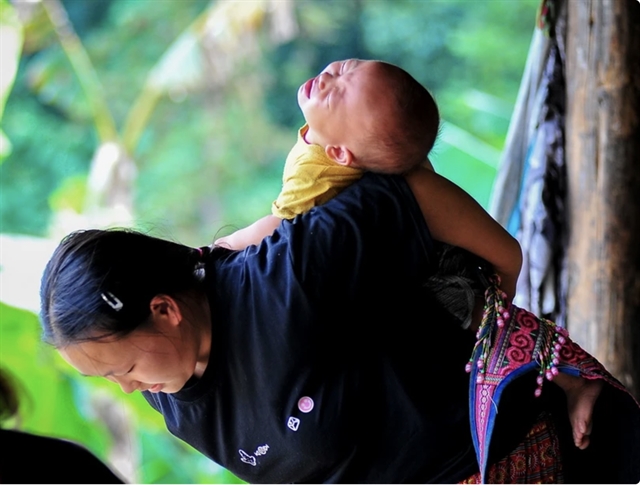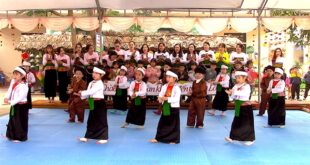
|
| Many ethnic women give birth under 18 years old, affecting their health. VNA/VNS Photo |
LÀO CAI – Prevention of child marriage and childbirth in women under 18 years of age among ethnic minority groups in northern province of Lào Cai has been facing many difficulties.
According to the provincial Ethnic Committee of Lào Cai Province, some ethnic groups still consider child marriage to be normal.
The province is currently facing many difficulties in implementing solutions to reduce the practice of early childbirth.
The committee’s statistics showed that, in 2023, the province recorded 712 ethnic minority women under 18 years old giving birth for the first time, an increase of nearly 16 per cent compared to the previous year.
The number of women giving birth for the first time under 18 years old is mainly in Sa Pa Town with 151 people, and Bắc Hà District with 143 people. In addition, in the whole province there are currently 166 ethnic minority children who have not been issued birth certificates.
These problems are related to the situation of child marriage in the locality.
Last year, Lào Cai has 112 people under the age of marriage living together or living with others as husband and wife (violating child marriage law), a decrease of more than 30 per cent compared to 2022, reaching the target assigned by the provincial People’s Committee.
In particular, there were 26 child marriages with one person under the legal age of marriage and 30 child marriages with both people under the legal age, with the Mông ethnic group accounting for 93.75 per cent.
During the year, the locality successfully campaigned to call 230 people to give up their intention of living together as husband and wife.
The people’s committees of communes administratively sanctioned 25 cases of child marriage with fines totalling VNĐ46 million (US$1,800).
However, according to the Ethnic Committee, there are still many difficulties in preventing child marriage and women under 18 giving birth for the first time.
Some ethnic groups still have the mindset of accepting and following their children’s wishes, considering child marriage as a normal thing in life, so changing their thinking takes time.
The local officials, especially at the grassroots levels, are still confused in implementing the work of preventing child marriage and consanguineous marriage.
They do not clearly understand the issue of child marriage and consanguineous marriage.
These difficulties stem from the customs and perceptions of ethnic groups, plus limitations in the information dissemination and intervention work of party committees, authorities and villages.
People’s educational level is still low. Many people are poor so they do not want to send their children to school, or their children have to drop out of school to work and support their families.
To promote socio-economic development and improve the quality of local human resources, the key task of Lào Cai Province this year is to strengthen intervention to reduce child marriage and childbirth in under 18-year-old ethnic women, as well as enhance information dissemination about child marriage and reproductive health to people, especially students.
The province resolutely handles violators of child marriage or other acts that violate the law on marriage and family, and carries out socio-economic development programmes to eliminate child marriage, consanguineous marriage, and childbirth in ethnic women under 18 years old.
Achievement in Quảng Nam Province
Meanwhile, in the central province of Quảng Nam, prevention of child marriage and consanguineous marriage for the last years has gained encouraging results.
According to statistics from the Ethnic Committee of Quảng Nam Province, in 2015 – 2020 the province recorded 830 cases of child marriage, decreasing by 704 cases as compared to the previous period of 2010 – 2015. The average decrease was 9.2 per cent per year.
There were 31 cases of consanguineous marriage, a decrease of 70 cases compared to the previous period of 2010 – 2015, an average decrease of 13.8 per cent per year.
To achieve this result, authorities in the province have implemented many specific measures, trying to gradually eliminate this problem.
Trần Duy Dũng, chairman of the People’s Committee of Nam Trà My District, said: “As one of the nine mountainous districts of the province, Nam Trà My District has more than 31,000 people, of which ethnic groups account for over 97 per cent, mainly the Xê Đăng, Ca Dong and M’Nông ethnic groups living together.”
“In the past, child and consanguineous marriage in ethnic group-inhabited areas was always a painful problem, greatly affecting the improvement of population quality and people’s health,” Dũng said.
“Recognising the harmful effects of child and consanguineous marriage, since 2021, the district has determined that reducing the issue in ethnic group-inhabited areas is a key task in the annual work agenda,” he said.
Activities of disseminating information and raising awareness about the consequences of this problem have been deployed synchronously from the district to grassroots level.
In the past three years, the district has had over 100 community media activities, more than 20 seminars on “Say No to Child Marriage and Consanguineous Marriage”, handed over 3,000 leaflets, installed 215 panels and outdoor boards, and broadcasted related programmes on district and commune radio, he said.
The district authority has promoted the roles of reputable people among ethnic groups such as village elders to mobilise and promptly prevent many child couples and closely related couples from marrying.
The district has urged communes and hamlets to sign commitments to prevent child marriage and consanguineous marriage.
Along with that, several models of extra-curricular activities, theatre competitions, and competitions about the situation of child marriage and consanguineous marriage among high school students are held regularly.
Thanks to that, many consanguineous marriages were prevented. The situation of consanguineous marriage in ethnic group-inhabited areas has been nearly eliminated and child marriage has also decreased sharply. In 2020, there were 12 – 15 cases of child marriage each year, but by 2022 there were only three cases.
Hồ Văn Lâm, head of an ethnic hamlet in Trà Cang Commune, said that the prevention of child marriage and consanguineous marriage among ethnic youths in the commune has been effectively implemented. However, this outdated custom has not been completely abolished. The reason is that people believed that marriages between relatives will be better and help keep wealth, he said.
According to the Quảng Nam Ethnic Committee, the basic cause of child marriage and consanguineous marriage is due to customs such as betrothal practices.
In addition, ethnic groups’ awareness about marriage and family is still limited. The idea of letting children get married early to avoid being a burden on their parents is still common.
The handling of administrative violations related to marriage and family issues is still not resolute.
Co-ordination between schools and families in managing and educating students is not tight enough. Besides, the explosive growth of social networks and unhealthy content on the internet, along with lack of knowledge about sex and reproductive health, leads to unwanted pregnancies that make students drop out of school and get married without consent, before legal age.
Faced with the situation, the province has developed a project on reducing child marriage and consanguineous marriage in ethnic group-inhabited areas in the period of 2021 – 2025.
Accordingly, the province sets a goal of basically eliminating child marriage and consanguineous marriage in ethnic minority areas by 2025, contributing to improving the quality of population and human resources in the areas.
The province strives to reduce the number of child marriages by 3 – 5 per cent on average each year and the number of consanguineous marriages by 5 – 7 per cent.
By 2025, the province aims to successfully prevent and limit child marriage and consanguineous marriage in ethnic group-inhabited areas.
More than 90 per cent of staff involved in ethnic affairs, especially in communes and villages, will be trained to improve awareness, capacity, advocacy, counselling and communication skills to change behaviour on child marriage and consanguineous marriage. VNS
- Reduce Hair Loss with PURA D’OR Gold Label Shampoo
- Castor Oil Has Made a “Huge” Difference With Hair and Brow Growth
- Excessive hair loss in men: Signs of illness that cannot be subjective
- Dịch Vụ SEO Website ở Los Angeles, CA: đưa trang web doanh nghiệp bạn lên top Google
- Nails Salon Sierra Madre
 VnExpress News The News Gateway of Vietnam
VnExpress News The News Gateway of Vietnam





